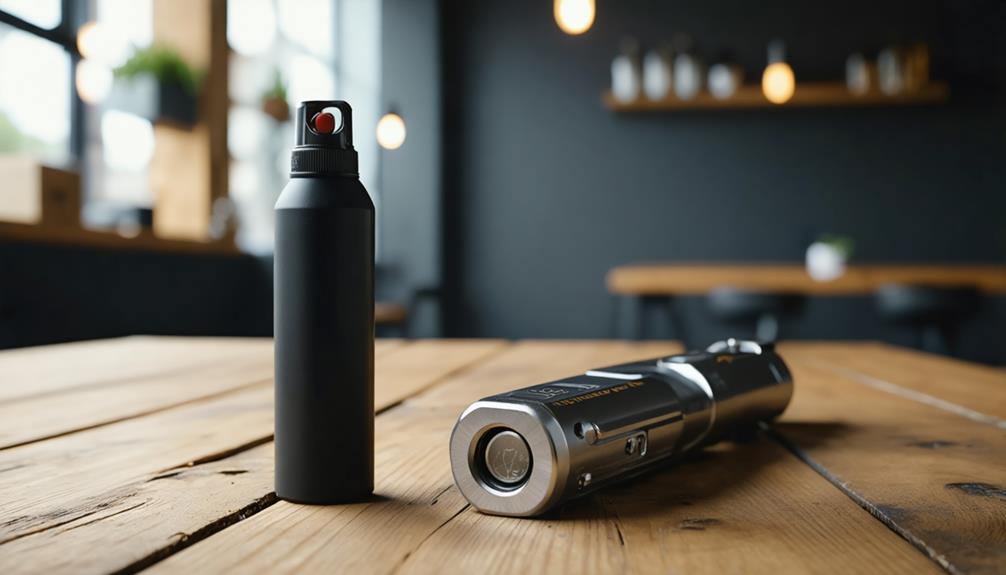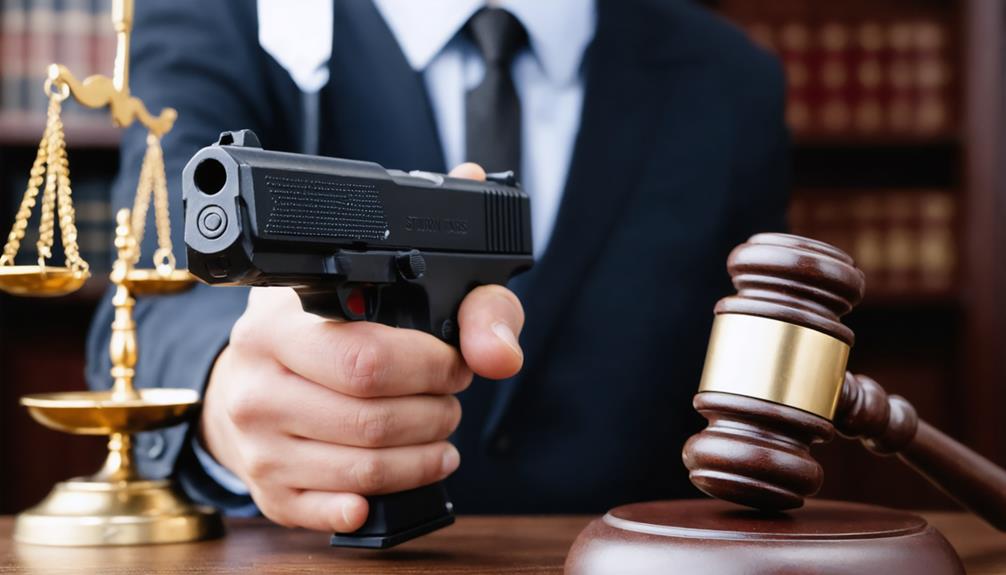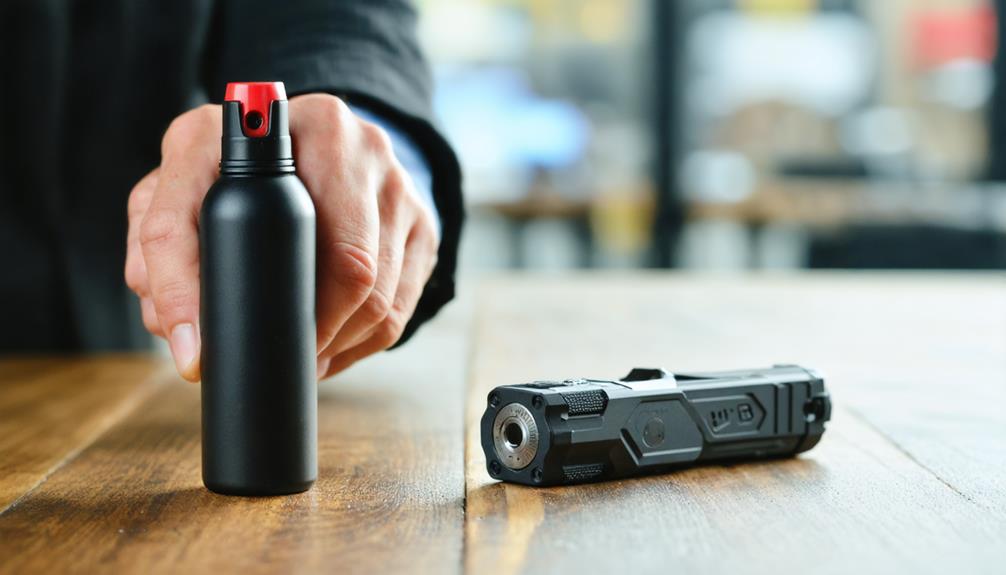
Brainstorm Security Shop

For Orders Over $99

On Any Of Our Products

Details On Refund Page

In the realm of personal safety, pepper spray and stun guns emerge as popular tools, each offering distinct mechanisms for self-defense. Pepper spray, with its ability to incapacitate from a safe distance, contrasts sharply with the direct contact requirement of stun guns, which deliver a potent electrical shock. However, the decision between these tools is not solely based on their functionality. Legal restrictions and personal comfort play pivotal roles in determining the most suitable option. As we explore these elements, the question remains: how does one effectively balance efficacy, legality, and personal preference in choosing the right self-defense tool?
Pepper spray, a commonly used self-defense tool, operates by causing temporary blindness, irritation, and discomfort to an assailant. Derived from the active ingredient oleoresin capsicum, this potent agent incapacitates attackers, allowing the user time to escape. Understanding the different pepper spray types and their specific applications is crucial for effective and responsible usage.
There are several pepper spray types available, each designed for varied situations. Stream spray is ideal for targeting specific threats, offering higher accuracy and reduced blowback risk, making it suitable for outdoor use. Cone mist, on the other hand, disperses the agent widely, covering a larger area and affecting multiple targets, though it is more susceptible to wind interference.
Foam and gel sprays provide a thicker consistency, minimizing airborne dispersion and potential contamination, thus preferred in confined spaces or indoor settings.
Pepper spray usage demands comprehension of its operational mechanics and legal implications. It is essential for users to familiarize themselves with the deployment technique, ensuring the canister is readily accessible and pointed accurately.
Additionally, understanding local regulations regarding possession and permissible deployment contexts is indispensable, as legal restrictions on pepper spray vary significantly across jurisdictions.
When it comes to self-defense, stun guns offer distinct advantages due to their effectiveness in temporarily incapacitating an attacker through electric shock. They are an essential component of modern self defense tactics, providing individuals with a non-lethal means to ensure personal safety. Stun guns work by delivering a high-voltage, low-amperage shock which disrupts the communication between the brain and muscles, causing temporary paralysis and disorientation. This allows the user to escape from a potentially dangerous situation without causing permanent harm to the assailant.
One of the primary benefits of stun guns is their ease of use, making them accessible for people of all physical capabilities. Additionally, their compact design allows for discreet carrying and quick access in emergencies. Furthermore, the psychological deterrent of a visible stun gun can often be enough to prevent an attack.
| Benefit | Description | Importance |
|---|---|---|
| Non-lethal | Causes temporary incapacitation | Ensures personal safety without harm |
| Easy to Use | Simple operation, no extensive training required | Suitable for all users |
| Portable | Compact and lightweight design | Convenient for everyday carry |
| Immediate Effect | Quick incapacitation upon contact | Provides immediate self-defense |
| Deterrent Factor | Visible presence can deter potential attackers | Prevents escalation of danger |
Incorporating stun guns into one’s self-defense strategy can significantly enhance personal safety while promoting responsible and effective self defense tactics.

Understanding the legal considerations surrounding stun guns is crucial for responsible ownership and use. Navigating the regulatory guidelines and self-defense laws associated with these devices can be complex, as they vary significantly from one jurisdiction to another.
In the United States, for instance, some states classify stun guns as firearms, while others do not impose strict regulations. Therefore, it is imperative for individuals to familiarize themselves with local laws to ensure compliance and avoid potential legal repercussions.
Several factors should be considered when evaluating the legality of stun gun possession and use:
Evaluating the effectiveness of personal defense tools, such as pepper spray and stun guns, involves a careful examination of their respective advantages and limitations.
In the realm of self-defense techniques, the effectiveness comparison between these tools often hinges on the context in which they are used, the user’s proficiency, and the situation’s dynamics.
Pepper spray is lauded for its ability to incapacitate an assailant from a distance, typically ranging from 8 to 12 feet. Its strength lies in the potent, inflammatory effects on the eyes, respiratory system, and skin. However, it requires precision in aim and is susceptible to environmental factors such as wind.
Conversely, stun guns demand close proximity to the assailant, delivering an electric shock that temporarily disrupts muscle function. Their effectiveness is immediate but necessitates direct contact, which could be risky in a volatile situation. Additionally, the psychological deterrent of a visible stun gun provides an advantage in some scenarios.
Both tools demand a level of user proficiency to maximize their effectiveness in real-world self defense techniques. Ultimately, the choice between pepper spray and stun guns depends significantly on personal comfort with the tool and the specific circumstances anticipated for their use.

Selecting an appropriate personal defense tool requires careful consideration of various factors, including the specific advantages and limitations discussed previously. When deciding between pepper spray and a stun gun, understanding the nuances of each tool can enhance personal safety and ensure suitability in various application scenarios.
Both tools serve unique purposes, and their effectiveness can vary significantly depending on the situation.
To choose the right tool, consider the following factors:
Ultimately, the choice between pepper spray and a stun gun should align with the individual’s lifestyle, environment, and the specific threats they anticipate facing.
In situations involving animal encounters, employing defensive techniques is crucial for personal safety. Utilizing tools such as pepper spray or stun guns can offer effective protection, though their legality and effectiveness may vary based on jurisdiction and species.
To ensure safety, store defensive devices securely, adhering to safety precautions. Employ storage solutions such as lockable cabinets or secured boxes, inaccessible to children or unauthorized individuals, to prevent accidental discharge or misuse of these items.
When traveling, understanding travel regulations is crucial. Airport security typically prohibits carrying these items in carry-on luggage. Check specific airline policies and local laws beforehand to ensure compliance and avoid potential legal issues during your journey.
Cartridge maintenance is crucial as expiration signs indicate diminished effectiveness. Most cartridges have expiration dates, typically ranging from two to four years. Regularly inspect and replace them to ensure optimal performance and reliability in emergency situations.
Proper disposal of expired or unused self-defense tools is crucial. Engage in responsible disposal practices to minimize environmental impact. Consult local regulations for hazardous waste management or return items to the manufacturer for safe handling.
In conclusion, both pepper spray and stun guns offer valuable self-defense capabilities, each with distinct advantages and limitations. Pepper spray provides a distance-based defense mechanism but can be affected by environmental factors, while stun guns require close proximity but deliver a potent electric shock. Legal considerations and situational effectiveness vary, necessitating a careful assessment of individual comfort levels and local regulations. Ultimately, selecting the appropriate tool requires informed decision-making to ensure personal safety and compliance with legal standards.
Brainstorm Security Shop
1867 Caravan Trail
Ste 105
Jacksonville, FL 32216
Call us toll free: (800) 859-5566